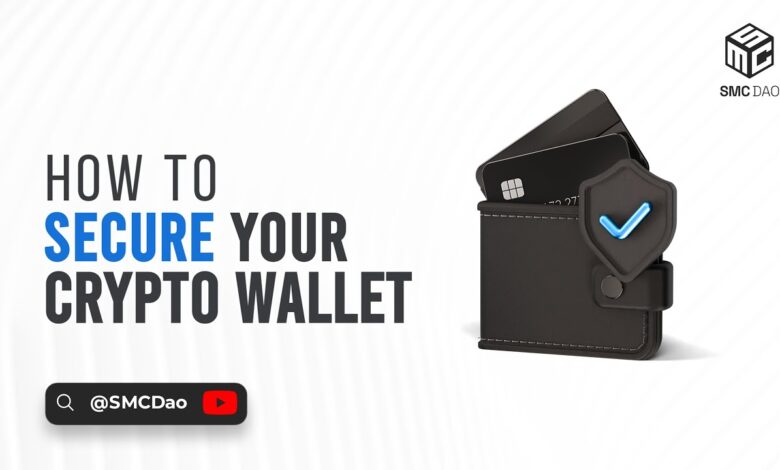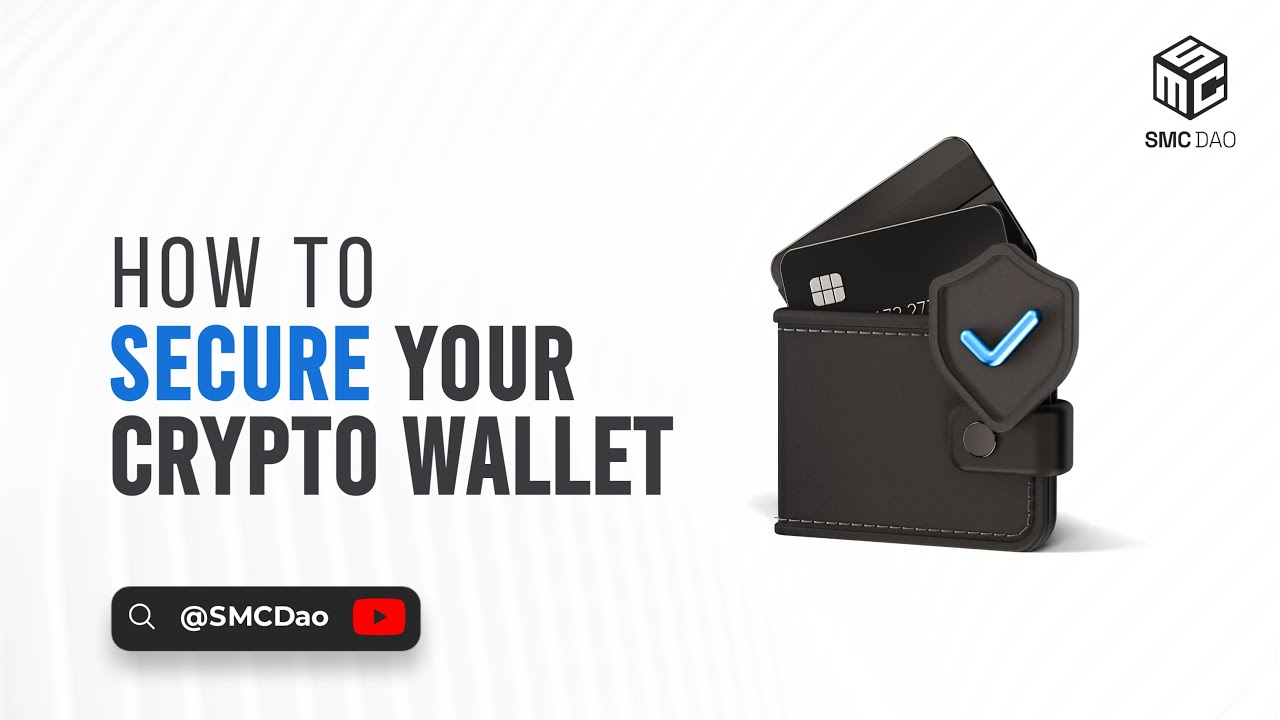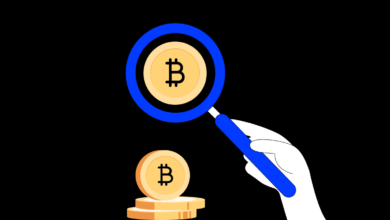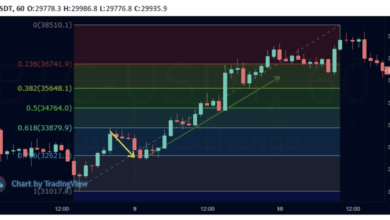
The Smartest Ways to Secure Your Crypto Wallet
The Smartest Ways to Secure Your Crypto Wallet from Hackers: Navigating the complex world of cryptocurrency requires a robust security strategy. From choosing the right wallet type to mastering password management, this guide will equip you with the knowledge to protect your digital assets.
Cryptocurrency has exploded in popularity, but with this growth comes increased risk. Hackers are constantly devising new methods to target crypto wallets, so understanding the vulnerabilities and implementing strong security measures is paramount. This in-depth exploration covers everything from choosing the right hardware wallet to practicing secure transaction habits.
Introduction to Crypto Wallet Security

Source: ytimg.com
Protecting your cryptocurrency holdings is paramount in today’s digital landscape. The allure of decentralized finance and the potential for high returns often overshadows the crucial need for robust security measures. A compromised crypto wallet can lead to significant financial losses, potentially eroding trust in the entire ecosystem. Understanding the different types of wallets, the potential threats, and the available security measures is essential for safeguarding your digital assets.Cryptocurrency wallets act as digital containers for your private keys, which grant access to your funds.
Without proper security, your crypto holdings become vulnerable to theft. The various wallet types, from simple mobile apps to sophisticated hardware devices, offer varying levels of security. Knowing the strengths and weaknesses of each is crucial for informed decision-making.
Types of Crypto Wallets
Crypto wallets are broadly categorized into hardware, software, and mobile wallets. Each type employs distinct security approaches, resulting in varying levels of protection.
- Hardware wallets are physical devices designed to store private keys offline. They typically utilize advanced security features like chip-based encryption and secure element storage. These features make them extremely resistant to online attacks and malware. A notable advantage is that the private keys are never transmitted over the internet, reducing the risk of compromise.
- Software wallets are applications installed on computers or laptops. They use encryption and access control measures to safeguard private keys. A potential weakness is that the device itself can be compromised by malware, leading to a loss of funds. Software wallets generally offer a balance between security and ease of access.
- Mobile wallets are applications accessible through smartphones. They offer convenience for on-the-go transactions. However, mobile devices are more vulnerable to physical theft, loss, or malware infection. The security of mobile wallets hinges on the strength of the device’s security features and the user’s vigilance in protecting their device and login credentials.
Attack Vectors Targeting Crypto Wallets
Crypto wallets are susceptible to various attack vectors, ranging from simple phishing scams to sophisticated exploits. Understanding these threats is crucial for implementing appropriate security measures.
- Phishing scams often involve fraudulent websites or emails designed to trick users into revealing their login credentials or private keys. These scams are prevalent in the digital realm and can be extremely effective if not recognized.
- Malware infections can compromise devices, stealing private keys or enabling unauthorized access to wallets. Regular updates and security software are essential for mitigating this risk.
- Social engineering tactics exploit human psychology to manipulate users into divulging sensitive information. These tactics often leverage social cues or relationships to create a sense of trust and encourage victims to reveal private keys.
- Brute-force attacks attempt to guess passwords or private keys through trial and error. Modern security measures, like multi-factor authentication, can effectively thwart these attempts.
Security Comparison of Crypto Wallet Types
The following table summarizes the security measures available for each type of crypto wallet, highlighting their strengths and weaknesses:
| Wallet Type | Security Measures | Strengths | Weaknesses |
|---|---|---|---|
| Hardware Wallet | Offline storage, advanced encryption, secure elements | High security, resistant to online attacks | Potentially less convenient, more expensive |
| Software Wallet | Encryption, access control, multi-factor authentication | Relatively easy to use, affordable | Vulnerable to malware, device compromise |
| Mobile Wallet | Biometric authentication, two-factor authentication, security apps | Convenience, portability | Vulnerable to physical theft, loss, and malware |
Strong Password Management Practices
Protecting your crypto wallet hinges significantly on the strength and security of your passwords. Weak passwords are an open invitation for hackers, allowing them to gain unauthorized access to your valuable digital assets. Robust password management practices are crucial for safeguarding your crypto wealth. This section delves into the best strategies for creating and managing strong passwords, emphasizing the importance of password managers and outlining common vulnerabilities to avoid.
Creating Strong Passwords
Effective password creation involves a multi-faceted approach. Simply choosing a memorable phrase isn’t enough. Strong passwords must combine complexity and memorability. Consider incorporating a mix of uppercase and lowercase letters, numbers, and symbols. Avoid using easily guessable information like birthdays, names, or common words.
A longer password, generally exceeding 12 characters, is significantly more resistant to brute-force attacks.
Utilizing Password Managers, The Smartest Ways to Secure Your Crypto Wallet from Hackers
Password managers are indispensable tools for securely storing and managing numerous passwords, including those for your crypto wallets. They automatically generate strong, unique passwords for each account, eliminating the need to remember them all. This significantly reduces the risk of password reuse, a common vulnerability that hackers exploit. Password managers encrypt your passwords, ensuring they’re protected from unauthorized access.
These tools often offer features for securely storing sensitive information, such as two-factor authentication codes, adding an extra layer of security. Furthermore, many reputable password managers provide syncing capabilities across devices, making it convenient to access your passwords from anywhere.
Password Complexity Metrics and Impact on Security
The complexity of a password directly correlates with its security. A simple password, containing only a few characters, can be cracked quickly. Conversely, a complex password, incorporating a mix of alphanumeric characters and symbols, is far more resistant to attacks.
| Password Complexity Metric | Description | Impact on Security |
|---|---|---|
| Length | The number of characters in the password. | Longer passwords are harder to crack. |
| Character Set | The variety of characters used (e.g., uppercase, lowercase, numbers, symbols). | Passwords with diverse character sets are more difficult to guess. |
| Randomness | How unpredictable the password is. | Random passwords are more secure than predictable ones. |
| Uniqueness | Whether the password is used for multiple accounts. | Using unique passwords for each account is critical to prevent breaches. |
Avoiding Common Password Vulnerabilities
Reusing passwords across multiple accounts is a significant security risk. If one account is compromised, hackers gain access to all accounts utilizing the same password. Weak passwords, easily guessed by automated tools, are also a common vulnerability. Employing insecure password storage methods, such as writing them down or storing them in plain text files, exposes them to potential theft.
Avoid sharing passwords with anyone, including friends, family, or colleagues. Regularly updating passwords, especially for sensitive accounts like crypto wallets, is crucial. Password reuse is one of the easiest ways for hackers to gain access to multiple accounts.
Password Management Best Practices
Use a strong, unique password for each account.Employ a reputable password manager for secure storage and generation.Regularly update passwords, especially for crypto wallets.Avoid sharing passwords with anyone.Be mindful of phishing attempts, which aim to trick you into revealing your passwords.
Multi-Factor Authentication (MFA) Strategies

Source: medium.com
Adding an extra layer of security to your crypto wallet is crucial in today’s digital landscape. Multi-factor authentication (MFA) stands as a powerful tool for enhancing the protection of your digital assets. By requiring multiple forms of verification, MFA significantly reduces the risk of unauthorized access, even if a hacker manages to obtain one factor.MFA works by verifying your identity through multiple independent channels.
This approach makes it considerably harder for attackers to gain access to your crypto wallet, even if they have compromised one authentication method. This is because they need to successfully breach multiple security layers. Essentially, it’s like having multiple locks on your door; each lock represents a factor, and a thief needs a key for each to get in.
Understanding the Concept of MFA
MFA is a security method that requires two or more authentication factors for verifying a user’s identity. These factors typically fall into three categories: something you know (e.g., a password), something you have (e.g., a security token), and something you are (e.g., biometric data). By combining these factors, MFA significantly strengthens the security posture of crypto wallets.
Different MFA Methods and Their Effectiveness
Various methods are employed for MFA, each with its own level of security. Understanding these methods and their vulnerabilities is essential for selecting the most appropriate approach for your needs.
- Email-based MFA: A verification code is sent to your registered email address. This method relies on the security of your email account. A compromised email account can be exploited for unauthorized access to your crypto wallet.
- SMS-based MFA: A verification code is sent to your mobile phone via text message. This method is convenient but can be vulnerable to SIM swapping attacks, where attackers gain control of your phone’s SIM card. This allows them to intercept verification codes. Furthermore, SMS messages can be intercepted by sophisticated man-in-the-middle attacks.
- Authenticator Apps (e.g., Google Authenticator, Authy): These apps generate time-based one-time passwords (TOTPs). They are considered more secure than email or SMS-based methods as they rely on the device itself, which is typically more secure than relying on email or phone networks.
Comparison of MFA Methods
The security of different MFA methods varies considerably. A comparative analysis highlights the strengths and weaknesses of each approach.
Protecting your crypto wallet is crucial, and knowing the smartest ways to do so is key. A big part of that involves understanding the broader picture of securing your crypto assets, which includes everything from strong passwords to avoiding phishing scams. Check out this helpful guide on How to Protect Your Crypto Assets from Hacks and Scams for more in-depth information on staying safe.
Ultimately, the smartest approach to securing your crypto wallet is a multi-layered strategy that includes robust security measures.
| MFA Method | Security Strength | Security Weakness |
|---|---|---|
| Email-based MFA | Relatively easy to implement | Vulnerable to compromised email accounts |
| SMS-based MFA | Convenient | Susceptible to SIM swapping attacks and man-in-the-middle attacks |
| Authenticator Apps | Generally more secure due to device-based verification | Requires a functioning device and a secure internet connection for initial setup. |
Secure Storage and Handling of Private Keys

Source: futurescope.co
Your private keys are the digital keys to your crypto fortune. They unlock your wallet and grant access to your digital assets. Protecting them is paramount. Compromising them means losing everything. This section dives deep into the importance of secure storage, exploring various methods and highlighting the potential risks.Understanding the critical role of private keys in crypto security is crucial.
They act as the gatekeepers to your digital assets, controlling access to your cryptocurrency. Losing or compromising these keys results in the irreversible loss of the associated funds.
Importance of Private Key Security
Protecting your private keys is the cornerstone of crypto security. Without secure storage, your entire crypto investment is at risk. A compromised private key can lead to the unauthorized transfer of your assets to malicious actors. This is why robust security measures are essential.
Different Storage Methods for Private Keys
Various methods exist for storing your private keys. Choosing the right method depends on your risk tolerance and technical expertise.
- Hardware Wallets: Hardware wallets are dedicated physical devices designed specifically for storing and managing private keys. These devices often use advanced security measures, like strong encryption and secure chipsets, to protect your private keys. Examples include Ledger Nano S and Trezor. They offer a high level of security, acting as a secure vault for your private keys, but require some technical setup and are typically more expensive than other options.
- Paper Wallets: Paper wallets involve manually writing down your private keys on a piece of paper. This method offers a certain level of portability and offline access, but it’s highly vulnerable to physical theft or damage. Paper wallets require extreme care in handling and storing the paper, and any form of compromise results in complete loss. They are best suited for small, non-essential amounts or test environments.
Risks Associated with Losing or Compromising Private Keys
The risks of losing or compromising private keys are significant. The consequences can range from minor inconvenience to complete financial loss.
- Theft or Loss of the Storage Device: If your hardware wallet is lost or stolen, your private keys are at risk. This is especially true for paper wallets where the physical paper can be lost or damaged. This is an often overlooked but critical risk, emphasizing the importance of secure storage for all crypto holdings.
- Phishing Attacks: Phishing attempts can trick you into revealing your private keys through deceptive emails or websites. These attacks are common and sophisticated. Always verify the legitimacy of any requests for your private keys.
- Malware and Viruses: Malware can infect your computer or mobile device, potentially stealing your private keys. Regular security software and updated operating systems can mitigate these risks. Keeping your software up to date and using reputable security solutions is essential.
Comparison of Private Key Storage Solutions
The security of different storage solutions varies significantly. Consider the following table for a comparison:
| Storage Method | Security Level | Ease of Use | Cost |
|---|---|---|---|
| Hardware Wallets | High | Medium | High |
| Paper Wallets | Low | Low | Low |
Hardware wallets generally offer the highest level of security, followed by software wallets, while paper wallets are the least secure. Ease of use and cost are also factors to consider.
Wallet Software Updates and Security Patches
Staying ahead of hackers requires vigilance and proactive measures. One crucial aspect of crypto wallet security is consistently updating your wallet software. This isn’t just about new features; it’s about patching vulnerabilities that could expose your funds to malicious actors. Outdated software is a significant weakness, making your wallet a prime target for attack.Regular updates are essential to maintaining a secure environment for your digital assets.
Security patches address known weaknesses in the software, effectively closing potential entry points for hackers. By consistently applying these updates, you significantly reduce the risk of your wallet being compromised. This proactive approach is vital in the ever-evolving landscape of cyber threats.
Importance of Regular Updates
Regular updates to your crypto wallet software are crucial for maintaining security. They often include critical security patches that address vulnerabilities exploited by hackers. Without these updates, your wallet remains susceptible to known exploits, increasing the risk of theft or unauthorized access to your funds.
Checking for and Applying Security Patches
Checking for and applying security patches is a straightforward process. Most reputable wallet providers have dedicated update mechanisms. These mechanisms usually involve downloading an updated version of the wallet software and following the instructions provided. Be sure to check your wallet’s support website or documentation for specific instructions.
Common Wallet Vulnerabilities and Corresponding Updates
| Vulnerability | Description | Typical Update Action |
|---|---|---|
| Outdated Libraries | Using outdated cryptographic libraries or other underlying components can create vulnerabilities. | Updates often include newer, more secure versions of these libraries. |
| Buffer Overflow | Vulnerabilities allowing hackers to overload the wallet’s memory with malicious data, leading to unexpected behavior and potential compromise. | Updates usually include code changes to prevent buffer overflows and other memory-related exploits. |
| SQL Injection | If the wallet interacts with a database, vulnerabilities can allow hackers to inject malicious SQL code to manipulate data or gain access. | Updates may include improvements to database interaction security. |
| Cross-Site Scripting (XSS) | These attacks manipulate wallet interfaces to inject malicious scripts that can steal data or redirect users to fraudulent sites. | Updates may strengthen the validation and sanitization of user inputs to prevent XSS. |
Potential Risks of Using Outdated Wallet Software
Using outdated wallet software exposes you to numerous risks. A significant concern is the presence of known vulnerabilities that haven’t been patched. This leaves your funds vulnerable to various exploits, potentially leading to the theft or loss of your crypto assets. Furthermore, outdated software may not be compatible with the latest security protocols, further increasing the risk of compromise.
There have been cases where older wallets have been targeted by hackers because the developers stopped supporting them. Staying up-to-date with your software is essential for maintaining security.
Transaction Verification and Monitoring
Securing your crypto wallet goes beyond just strong passwords and secure storage. A crucial aspect often overlooked is the meticulous verification and monitoring of transactions. Understanding how to verify outgoing transactions and spot potential fraudulent activity is paramount for safeguarding your digital assets. This involves a proactive approach to transaction management, ensuring every move you make is deliberate and safe.
Importance of Verifying Transactions
Verifying transactions before sending them is akin to double-checking a payment slip before signing it. It’s a fundamental step in preventing accidental or malicious mishaps. Mistakes in addresses, incorrect amounts, or unauthorized access can lead to irreversible losses. Carefully reviewing each transaction details, including the recipient’s address, amount, and transaction fee, is essential to prevent accidental transfers to wrong wallets or scams.
Importance of Monitoring Transaction Activity
Regular monitoring of transaction activity is as vital as regularly checking your bank account statements. This proactive approach allows you to identify suspicious patterns or anomalies in your wallet’s activity, such as unusually high transaction volumes, unexpected recipients, or transfers to unfamiliar addresses. It’s like having a security system that alerts you to any potential threats.
Creating a Secure Transaction Process
A secure transaction process involves several key steps. First, meticulously double-check all transaction details. Compare the destination address to the intended recipient, and cross-reference the amount with your intended transfer. Next, ensure that the transaction fee is reasonable and expected. Finally, utilize a secure environment for the transaction, preferably a dedicated device or platform with strong security measures, and never use public Wi-Fi for sensitive transactions.
Role of Transaction Monitoring Tools
Transaction monitoring tools provide an automated layer of security. These tools continuously track and analyze your transaction history for suspicious patterns, such as recurring transfers to unfamiliar addresses or unusual transaction volumes. Some tools also incorporate machine learning algorithms to identify anomalies in real-time. These tools are akin to advanced security software, constantly scanning for threats and raising alerts for potential issues.
These alerts will notify you about suspicious transactions or unusual activity, allowing for immediate action to prevent losses.
Protecting your crypto wallet is crucial, especially when regular folks are finding success with strategic crypto investments, like detailed in this article How Regular People Are Building Wealth Through Strategic Crypto Investments. Strong passwords, two-factor authentication, and regular security audits are key. Ultimately, staying informed and proactive is the smartest way to safeguard your digital assets.
Avoiding Phishing and Social Engineering Attacks
Protecting your crypto wallet goes beyond just strong passwords and secure storage. A significant threat often overlooked is the insidious nature of phishing and social engineering attacks. These tactics exploit human psychology to trick users into revealing sensitive information, including private keys and login credentials. Understanding these methods and recognizing the red flags is crucial for safeguarding your digital assets.Phishing and social engineering attacks are deceptive attempts to manipulate individuals into divulging personal information.
These attacks often leverage psychological manipulation, urgency, and perceived authority to gain access to sensitive data. Cybercriminals use various tactics, from spoofed emails and websites to fabricated messages and social media interactions, to trick unsuspecting victims.
Common Phishing Attempts Targeting Crypto Users
Cryptocurrency users are particularly vulnerable to phishing attempts due to the inherent value associated with digital assets. Criminals craft elaborate schemes designed to mimic legitimate platforms or services, luring users into revealing their private keys or login details. Common examples include:
- Fake cryptocurrency exchange websites: These websites mimic legitimate cryptocurrency exchanges, tricking users into logging in with their credentials, thereby gaining access to their accounts.
- Phishing emails claiming urgent account updates or security warnings: These emails often contain links to fraudulent websites designed to steal login credentials.
- Fake support tickets or messages: These messages attempt to establish trust by claiming to be from legitimate support channels. They may ask for sensitive information, such as private keys, under the guise of resolving an issue.
- Social media scams: Criminals may use social media platforms to create fake profiles or impersonate trusted individuals, luring users into revealing personal information.
- Fake investment opportunities or promotions: These scams promise high returns on investment or participation in exclusive promotions, enticing users to provide sensitive information for “privileged access”.
Recognizing and Avoiding Phishing Scams
Critically evaluating the source and context of communications is essential to avoid falling victim to phishing scams. Pay close attention to details that seem out of place or unusual. Genuine communications from legitimate services rarely use aggressive or urgent language.
- Verify the sender’s email address or website URL: Carefully scrutinize the email address or website URL. Look for subtle misspellings or variations that could indicate a fraudulent attempt.
- Be wary of unsolicited requests for personal information: Never share your private keys, login credentials, or other sensitive information unless you are absolutely certain of the legitimacy of the request.
- Do not click on suspicious links or attachments: Hover over links before clicking to verify the destination URL. Avoid opening attachments from unknown senders.
- Check for security measures: Legitimate platforms typically use secure connection protocols (HTTPS) and display security badges.
- Use strong passwords and enable multi-factor authentication (MFA): This provides an extra layer of security, making it more difficult for attackers to access your accounts even if they obtain your password.
Red Flags for Potential Phishing Attempts
Identifying potential phishing attempts is crucial to avoiding scams. The following table Artikels common red flags to watch out for:
| Red Flag | Description |
|---|---|
| Suspicious sender | Emails or messages from unfamiliar or suspicious senders. |
| Urgent tone | Emails or messages creating a sense of urgency or demanding immediate action. |
| Grammar and spelling errors | Emails or messages containing noticeable errors in grammar and spelling. |
| Unexpected requests for sensitive information | Requests for private keys, login credentials, or other sensitive information without prior notification. |
| Unfamiliar websites | Websites that look similar but are not identical to legitimate websites. |
Importance of Cold Storage and Offline Wallets
Protecting your cryptocurrency holdings involves more than just strong passwords and multi-factor authentication. A crucial layer of security often overlooked is cold storage, utilizing offline wallets to safeguard your private keys from online threats. This method dramatically reduces your vulnerability to hacking and exploits.Cold storage solutions fundamentally isolate your private keys from the internet, preventing malicious actors from accessing them.
Protecting your crypto wallet is crucial, and understanding the smartest security measures is key. But did you know that analyzing crypto charts like a pro can indirectly bolster your wallet security? Knowing the market trends and potential price fluctuations, as detailed in How to Analyze Crypto Charts Like a Professional Trader , can help you make more informed decisions about when to buy, sell, or hold onto your crypto, ultimately minimizing the risk of losing funds.
Ultimately, the best way to safeguard your crypto wallet is a combination of robust security practices and a thorough understanding of the market.
This separation is the cornerstone of their security, making them a critical component of a robust crypto security strategy.
Cold Storage Explained
Cold storage, in the context of cryptocurrency, refers to storing your crypto assets’ private keys offline. This means the private keys are not accessible through any internet-connected device. This physical separation drastically reduces the risk of hacking, malware, and phishing attacks that target online wallets.
Benefits of Cold Storage Solutions
Cold storage significantly reduces your vulnerability to online threats. The key advantage is the complete removal of your private keys from the internet, preventing direct access by malicious actors. This approach also minimizes the risk of malware infecting your computer and stealing your private keys. Furthermore, cold storage solutions typically involve physical separation, making them extremely difficult to compromise in physical attacks.
Cold Storage Options and Security Features
- Hardware Wallets: Hardware wallets are physical devices that securely store your private keys. These wallets often use advanced security features like embedded secure elements and cryptographic algorithms. Examples include Ledger Nano S and Trezor Model T. These devices are designed to be tamper-resistant, protecting your private keys from unauthorized access. Their secure elements are crucial in preventing attacks that compromise the underlying software or operating system.
- Paper Wallets: Paper wallets involve generating a unique address and private key pair and writing them down on paper. While simple, they require careful handling and storage to prevent loss or theft. A significant advantage of paper wallets is their physical separation from the internet, ensuring your keys are inaccessible to online attackers. However, they are vulnerable to physical theft or damage.
- Offline Software Wallets: Some software wallets allow for the creation of a local, offline copy of your private keys. These copies can be backed up offline, providing a level of protection against online threats. Their security relies heavily on the user’s commitment to keeping the offline copy secure and safe from physical damage or theft. This approach often necessitates a separate device and a secure backup procedure.
Mitigating Online Vulnerabilities with Cold Storage
Cold storage effectively mitigates vulnerabilities inherent in online wallets. Online wallets, by their nature, are connected to the internet, making them susceptible to hacking attempts, malware infections, and phishing scams. Cold storage, on the other hand, isolates your private keys from these online threats, creating a significant barrier against unauthorized access. This isolation reduces the attack surface considerably.
Choosing the Right Cold Storage Solution
The ideal cold storage solution depends on individual needs and risk tolerance. Hardware wallets offer the highest level of security but might come with a higher price point. Paper wallets are a cost-effective option but require careful handling and storage. Offline software wallets provide a balance between cost and security. Consider the level of security needed, the budget available, and the ease of use when selecting a cold storage solution.
Implementing Secure Network Connections
Protecting your crypto wallet extends beyond just strong passwords and software updates. A crucial element often overlooked is the security of the network connection you use to access your wallet. A compromised network can expose your sensitive private keys and transaction details, leading to significant financial loss. Understanding and implementing secure network practices is therefore paramount.
Importance of Secure Network Connections
A secure network connection acts as a shield, preventing unauthorized access to your crypto wallet. It’s the first line of defense against hackers intercepting your data during transactions. Unencrypted connections, like those using public Wi-Fi, leave your private keys and transactions vulnerable to eavesdropping. Employing secure protocols like HTTPS and VPNs significantly reduces this risk.
Using VPNs for Enhanced Protection
VPNs, or Virtual Private Networks, create an encrypted tunnel between your device and the internet. This tunnel masks your IP address, making it harder for hackers to track your online activities and target your crypto wallet. Using a VPN during crypto transactions, especially on public Wi-Fi, is a strong measure against man-in-the-middle attacks. A VPN effectively obscures your location and online activity, offering a critical layer of protection for your crypto transactions.
Importance of HTTPS for Secure Websites
When accessing crypto wallet platforms or exchanges, always ensure the website uses HTTPS (Hypertext Transfer Protocol Secure). The “s” signifies that the connection is encrypted, protecting your data from being intercepted. This encryption prevents hackers from reading your login credentials or transaction details as they travel between your device and the website. Websites without HTTPS should be avoided for any sensitive financial activity.
Comparing VPN Services
| VPN Service | Security Features | Pros | Cons |
|---|---|---|---|
| NordVPN | Military-grade encryption, double VPN, kill switch, obfuscation | Robust security, large server network, reliable performance | Can be slightly more expensive than some competitors |
| ExpressVPN | High-speed connections, strong encryption, multiple protocols | Excellent speed, user-friendly interface, wide server coverage | Higher price point compared to some free alternatives |
| Surfshark | Strong encryption, kill switch, unlimited simultaneous connections | Affordable pricing, unlimited device connections, good speed | Limited server locations compared to some other options |
| ProtonVPN | Strong encryption, focus on privacy, no-logs policy | Strong privacy focus, excellent for users concerned about privacy, good speed for many uses | May have fewer servers than other options, potentially slower speeds in certain locations |
Note: This table provides a simplified comparison. Specific features and performance can vary depending on your location and usage. Always research and compare services before selecting a VPN.
Regularly Backing Up Your Wallet Data: The Smartest Ways To Secure Your Crypto Wallet From Hackers
Regularly backing up your crypto wallet data is a crucial step in safeguarding your digital assets. A comprehensive backup strategy acts as a safety net, protecting you from data loss due to hardware failures, software corruption, or even malicious attacks. Without backups, recovering your wallet and its contents could be a daunting and potentially impossible task.Losing access to your private keys, which are essential for controlling your cryptocurrency, is catastrophic.
A robust backup plan ensures you can restore your wallet and its funds if something goes wrong. This proactive measure is essential for preserving your investment and peace of mind.
Importance of Regular Backups
Regular backups are not just a good idea; they are a necessity for safeguarding your crypto holdings. Data loss can stem from various sources, including accidental deletion, device malfunctions, or even cyberattacks. A secure backup acts as an insurance policy, ensuring you can retrieve your wallet data in case of unforeseen circumstances.
Different Backup Methods and Their Security
Several methods exist for backing up your wallet data. Each method has its own security considerations.
- File-based backups: This involves copying your wallet’s files (often containing private keys) to an external storage device. This is a straightforward method, but security relies heavily on the security of the external storage. Always store backups in a secure location, ideally disconnected from the internet, to prevent unauthorized access.
- Cloud-based backups: Services like Dropbox, Google Drive, or specialized crypto wallet backup services offer cloud storage. While convenient, cloud security is crucial. Choose reputable providers with strong encryption and access controls. Ensure your cloud backups are encrypted, and never store your private keys in plain text within the cloud.
- Hardware wallets: Many hardware wallets have built-in backup features. These often involve generating backup codes or QR codes that allow you to restore your wallet. Security is generally strong due to the hardware’s isolation and robust encryption.
Creating a Secure Backup Strategy
A secure backup strategy should be tailored to your specific needs and risk tolerance. It should consider the method used, the security of the storage location, and the frequency of backups.
- Choose a backup method: Select a method that aligns with your technical skills and comfort level. If you’re new to crypto, a hardware wallet with built-in backup features might be a good starting point.
- Establish a secure storage location: Offline storage is crucial. A physical hard drive stored in a safe or a secure cloud service with robust encryption are examples of suitable options. Never keep backups on the same device as your wallet software.
- Regular backup schedule: Implement a schedule for regular backups. Daily or weekly backups are recommended for crucial data protection.
- Verification and Testing: After each backup, verify that the backup is complete and recoverable. Test the restoration process periodically to ensure the backup remains functional and accessible.
Backup Tools and Their Importance
Several tools can automate and simplify the backup process. These tools often offer features for scheduling, encryption, and verification. Using a reputable backup tool is often more efficient than manual methods.
Regular and reliable backups are critical for safeguarding your cryptocurrency assets.
Outcome Summary
In conclusion, securing your crypto wallet involves a multifaceted approach. By understanding the various types of wallets, implementing strong passwords and multi-factor authentication, and practicing secure storage and transaction habits, you can significantly reduce your risk of becoming a victim of a crypto-related crime. Remember, proactive security measures are crucial in this dynamic digital landscape.
Question Bank
What’s the difference between hardware and software wallets?
Hardware wallets are physically separate devices that store your private keys offline, offering enhanced security. Software wallets reside on your computer or mobile device, which requires extra caution with your device security. Both have pros and cons.
How often should I update my wallet software?
Regularly updating your wallet software is crucial. Security patches often address vulnerabilities that hackers exploit. Check for updates frequently and apply them promptly to maintain optimal protection.
What are some common phishing tactics used against crypto users?
Phishing attacks often involve deceptive emails or websites that mimic legitimate crypto platforms. Be wary of unsolicited requests for your private keys or login information. Always double-check the legitimacy of links and websites before clicking.
What is cold storage and why is it important?
Cold storage involves storing your crypto assets offline, reducing the risk of online attacks. This method typically uses hardware wallets or paper wallets to safeguard your private keys. Offline storage is a crucial component of robust security practices.






